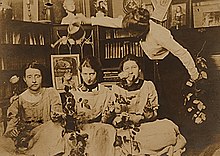The Plastic Club

Plastic Club members in their early Chestnut Street studio, ca. 1901
|
|
| Established | 1897 |
|---|---|
| Founder | Emily Sartain |
| Founded at | Philadelphia, Pennsylvania |
| Purpose | arts organization for women to promote collaboration and members' works |
| Headquarters | 247 South Camac Street |
| Location | |
|
President (1897)
|
Blanche Dillaye |
| Slogan | "All passes. Art alone Enduring stays to us; The Bust outlasts the throne,— The Coin, Tiberius" |
| Website | www |
The Plastic Club is an arts organization located in Philadelphia, Pennsylvania. Founded in 1897, the Plastic Club is one of the oldest art clubs in the United States. It is located on the 200 block of Camac Street, the "Little Street of Clubs" that was a cultural destination in the early 1900s. Since 1991, the club's membership also includes men.
The Plastic Club was founded by art educator Emily Sartain. It was founded as an arts organization for women to promote collaboration and members' works, partly in response to the Philadelphia Sketch Club, an exclusively male arts club. The first President was the etcher Blanche Dillaye. The motto of the club was taken from a poem by Theophile Gautier:
All passes. Art alone
Enduring stays to us;
The Bust outlasts the throne,—
The Coin, Tiberius
The club offered art classes, social events, and exhibitions. Its annual masquerade party was called "the Rabbit."
Early members included Elenore Plaisted Abbott, Paula Himmelsbach Balano, Cecilia Beaux, Fern Coppedge, Elizabeth Shippen Green, Charlotte Harding, Frances Tipton Hunter, Violet Oakley, Emily and Harriet Sartain, Jessie Willcox Smith, and Alice Barber Stephens, many of whom had been students of Howard Pyle. When the fall exhibition was held in 1898, the works of Pyle's former students—Elizabeth Fearne Bonsall, Elizabeth Shippen Green, Jessie Willcox Smith, Charlotte Harding, Violet Oakley, and Angela De Cora—were singled out.
In 1918, the club was involved in the founding of the Philadelphia School of Occupational Therapy, reflecting the connection between occupational therapy and the Arts and Crafts movement in the United States between the Civil War and World War I.
...
Wikipedia
